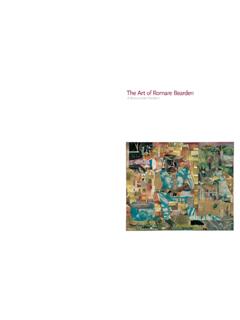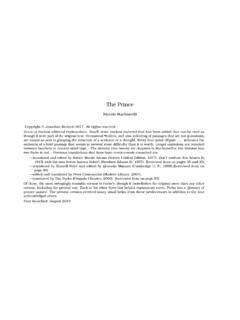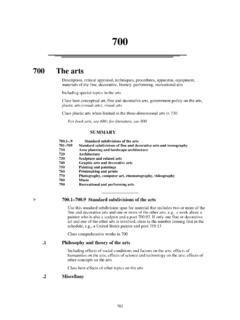Transcription of What things cost in Ancient Rome - Pacific Lutheran University
1 What things cost in Ancient RomeWhen studying Ancient Rome, it is only natural to wonder what the price of everyday items might havebeen. In order to fully understand the price of an item, you must also consider the wages workersreceived at the time the item was you study the information below, it is helpful to understand that professions were valueddifferently in Ancient times than they are today. Likewise, the value of items was different then thannow. For instance, in today s world, one might spend 20% of their total income on food, but in ancienttimes the cost may have been 50% or more of one s total income.
2 In fact, during parts of the history ofRome, food costs were so high that without free wheat subsidies from the government, the commonpeople would not have been able to survive! These subsidies were known as doles and according toAEJ Morris s History of Urban Form [1970 George Godwin LTD], up to 1/3 of the citizens of the capital cityreceived this public formed the foundation of the common Roman s diet. It was not uncommon for grain to be theonly thing a poor Roman ever ate. The cost of baking bread was very high to a poor Roman, so if noaccess to a communal, public oven could be had, the grain would be crushed and made into a porridgeknown as puls that was likely similar in taste and texture to modern polenta.
3 While we take it forgranted today, meat was an extravagant luxury that most Romans could not afford to indulge was another expensive proposition. One libra (Roman pound, just under _ of a modernpound - 326 grams), of fine silk cost more than a dozen human beings. It seems absurd to us today, butsuch was the case, because Ancient Romans lacked the production machines of today that make cheapfabric possible. For the commoners, fashion was not a consideration- clothing was utilitarian, had to bedurable, and was patched until finally the garment became the thing from which patches were taken forits , the cost of living has expanded to consume all of the income that is available to themajority of the people in the society.
4 As technology has enabled faster production, technology has alsointroduced new things to consume the income the increased productivity creates. The Ancient Romansdid not have many things to pay for in comparison to life today, yet it was every bit as much a strugglefor them to survive as it is today- and probably, it was even more of a struggle for you read the data below, consider what you might have been in Ancient Rome. Would you havebeen a carpenter? A mason? Would you have been fortunate enough to receive an education andbecome an advocate ( Ancient equivalent of the modern lawyer)?
5 Pick your profession, and then take alook at the kind of food and clothing you would have been able to afford. You might gain a newappreciation for modern life !All the prices and wages are listed in denarii communes, which were not actually silver denarii as weusually think of when discussing Ancient Roman coinage. Denarii communes, or , were notationalcurrency. What this means is, an exchange rate was given, telling how much of the currency incirculation at that time (nummii) it took to equal one This made it easy to change the value of themoney in circulation, without having to rewrite and redistribute the entire Edict.
6 A series of exchangetables are at the end of this in 301 AD in the Roman EmpireAll data based on Diocletian s Edict of Maximum Prices issued in 301 ADGeneral Laborersbrick maker, for every 4 fired bricks and preparation of the maker, for every 8 sun dried bricks, and preparation of the (based on specified bath attendant wage)..25farm laborer, with burner, with driver, camel driver, with cleaner, working a full day, with , with carrier, working a full day, with other general Laborersbarber, per maker, with , with maintenance, mason, with painter, with (Wool weaver)
7 , per paving and walls custodian, with mosaics worker, with maker, with plaster worker, with maker, for a quaternion, white or yellow of a river vessel, with of a seagoing vessel, with floormaker , with blacksmith, with , with painter, with , for opening a pleading a , for the best writing 100 second quality , for writing a petition or legal in Ancient RomeA teacher in Ancient Rome would have lived in the home of a wealthy patrician, who would haveprovided the teacher with food and clothing appropriate to the house. The teacher would nothave had much spending money, but would have lived comfortably just the same.
8 These aresalaries in denarii per month, per or Latin literature or of rhetoric or public in Ancient RomeSoldiering was one of the best ways a Roman male could provide for his family. The base wage waslow, not enough to live on. Four times a year, a soldier received a Donative greater than his annualbase pay. Additionally, soldiers received an annual Annona subsidy for grain purchases. The bestsoldiers hoped to be recruited to the Praetorian Guard, the soldiers who guarded the Emperor. Thesesoldiers were paid roughly 3 times the base wage of the average soldier, and likely enjoyed manyadditional privileges as had high expenses in their profession, but they still came out much better than the averagecitizen even after expenses.
9 The soldiers were expected to pay for much of their own equipment,rations, and clothing. They even had to pay part of the cost of burial for their fallen from their Pay:average Roman soldier, Guard, grain annona (1 per year)..600donative (4 per year)..2500 Additionally, every soldier received a grain allotment of30 modii of wheat per year that would be Annual Pay for an average Roman ,400 For a Praetorian ,100 Compare that to a general laborer working 305 days a Costs:boots, without , , for a for a for an for a double for a sword in 301 AD in the Roman EmpireAll data based on Diocletian s Edict of Maximum Prices issued in 301 ADThe Edict of Maximum Prices was an attempt to control runaway inflation and poverty in the penalty for exceeding the prices of the Edict was severe: death.
10 Not satisfied to execute just theseller, Diocletian decreed that the buyer was to be executed as well. As a final measure, if a sellerrefused to sell his goods at the stated price, the penalty was FoodsPrices refer to one modius unless otherwise indicated. 1 modius=8 liters dry , , , , , , & Vegetablescabbage or lettuce, grapes, , , one, up in 301 AD in the Roman EmpireFood (continued)Meats and FishPrices refer to one libra unless otherwise noted. 1 libra=326 grams or just under _ , , , , depending on , depending on , Beer & OilPrices refer to one sextarius.







